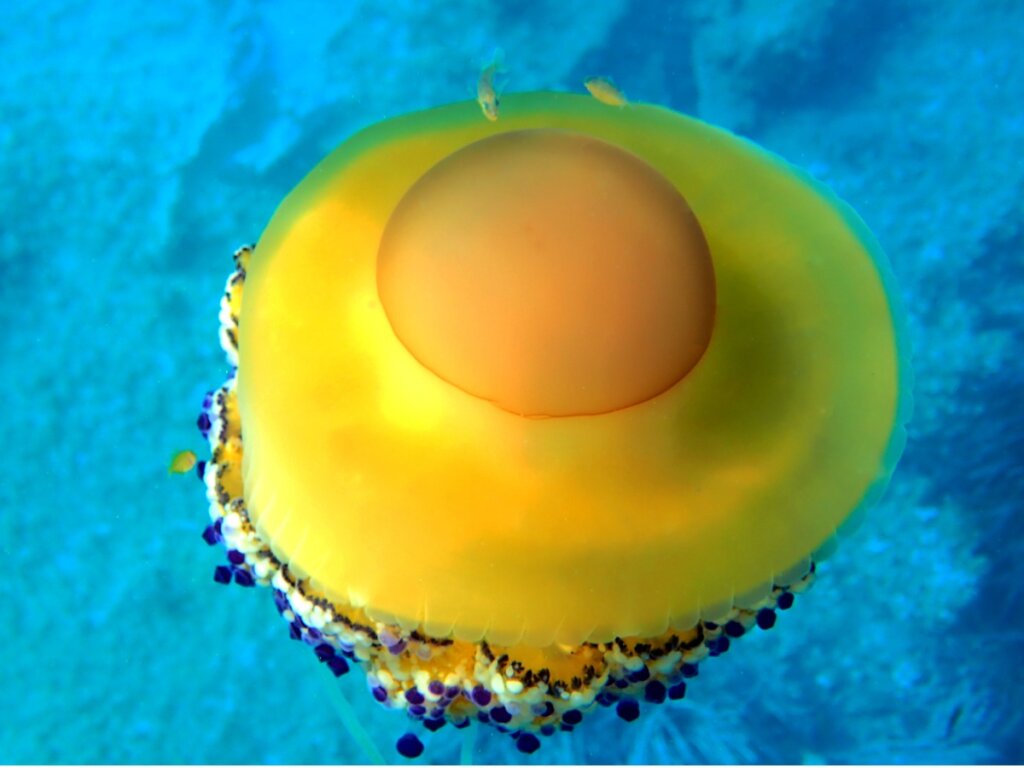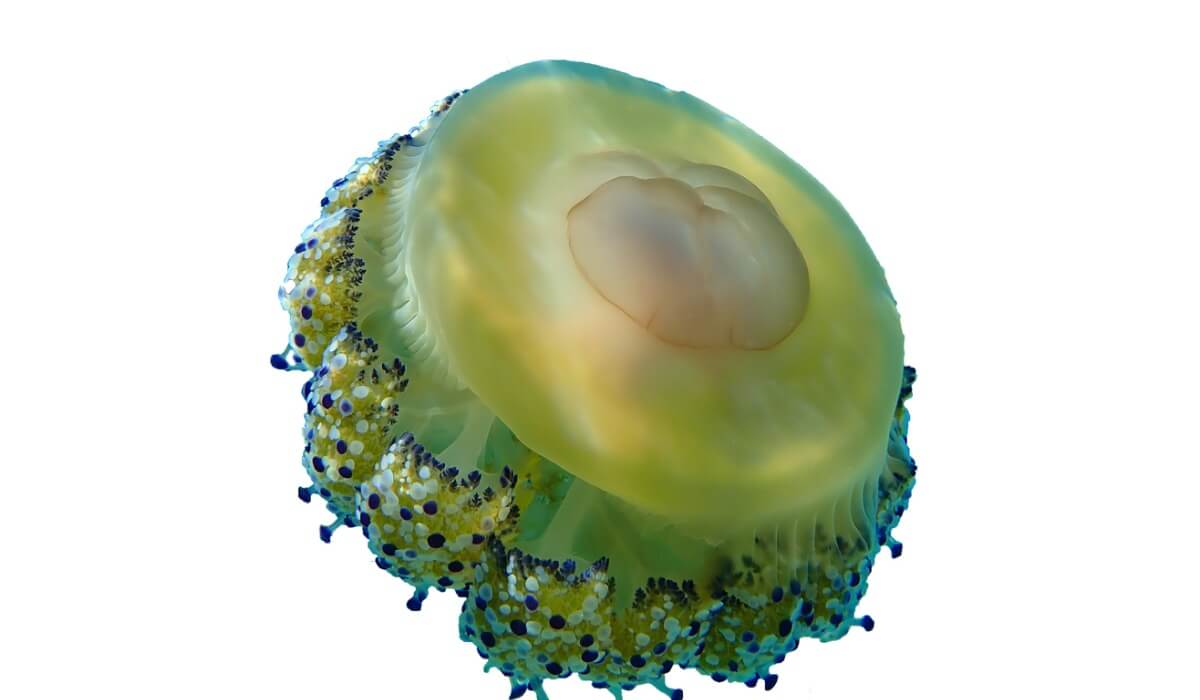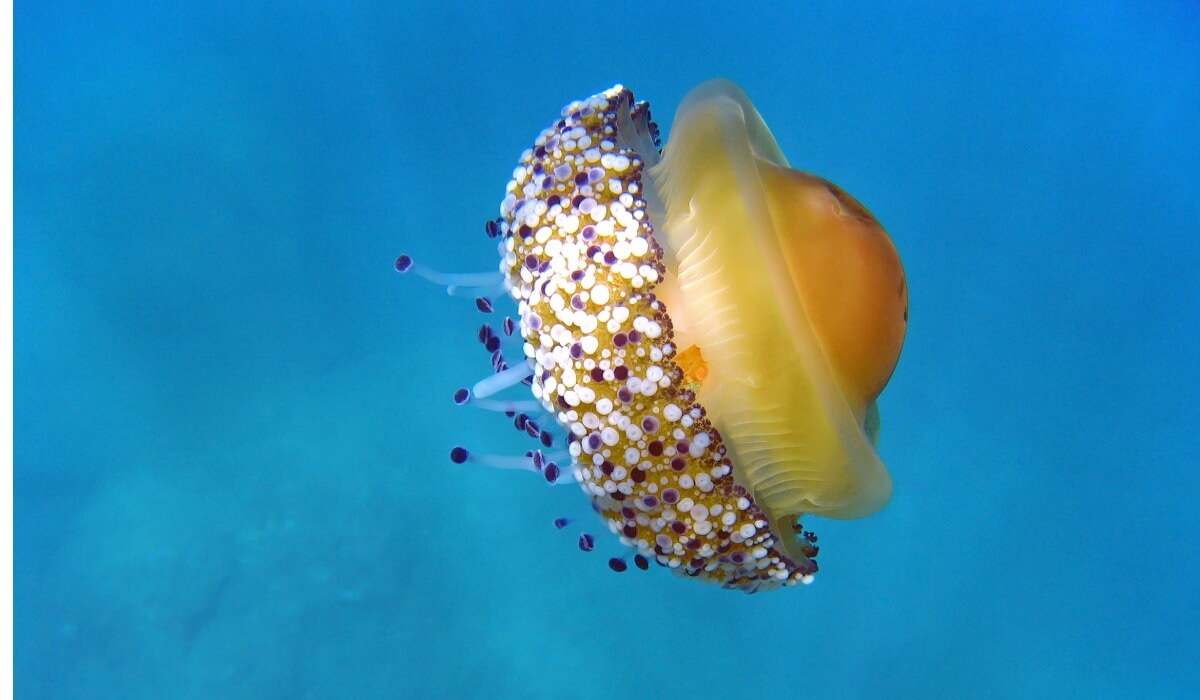The Fried Egg Jellyfish: Distribution, Characteristics and Feeding

If you practice diving, you may come across one of the oldest animals in Earth’s history: the fried egg jellyfish. You’re sure to be intrigued by the name! This pelagic invertebrate resides mainly in the waters of the Mediterranean Sea, although it’s also found in the Aegean Sea, the Adriatic Sea, and the Mar Menor.
So, why has this invertebrate received this name? If you’ve seen the main photo then you’ll know the answer to that question! But how does it differ from other jellyfish? We’ll answer these questions and more in this article!
Characteristics of the fried egg jellyfish
If you look at its body, you can see that it literally looks like a fried egg! Both the ‘yolk’ and the ‘white’ constitute the umbrella, the name given to the part of the body that looks like an umbrella or parasol. Here are more fascinating facts about this species.

A member of the Scyphozoa class
The scientific name we recognize this species by is C. tuberculata and it belongs to the Scyphozoa class. Being part of the Scyphozoans, it’s one of the more typical and best-known types of jellyfish. However, there are other families of jellyfish, such as the Hydrozoa, which has species as curious as the blue button jellyfish, Porpita porpita.
They swim vertically
The fried egg jellyfish swims vertically using the contraction and expansion of its umbrella. Likewise, you can also turn your body and move through the sea.
Its size is variable
When talking about the mean diameter of this invertebrate, we can point out that it’s variable. In other words, you can find specimens that exceed 40 centimeters (16 inches), as well as individuals that are 20 centimeters (8 inches).
There are other species that don’t even reach 10 centimeters (4 inches) and others that can be as much as a meter (3.3 feet). However, in the Mediterranean Sea, C. tuberculata can be said to hold the title of the largest jellyfish, although it has a rival in the Rhizostoma pulmo.
The coloring of the fried egg jellyfish is fascinating
Among the most striking characteristics of this jellyfish, the shades of its umbrella, as well as other parts of its body, stand out. You can observe colors ranging from white to cream or light brown tones.
In addition, the central part differs from the rest of the body with a stronger tone, which can range from red to dark brown. Nor can we forget its purple tentacles that sometimes change color – something that can be an indication of the quality of the water.
She has an entourage that follows her everywhere
Although the tentacles of this jellyfish are loaded with venom – which can go off at any time – certain fish are immune to toxins, such as horse mackerel. Thanks to this association, the fish receive protection from this jellyfish, and they can take advantage of the food that this species still hasn’t digested.
May cause painful stings
As you may already know, jellyfish release a stinging mucous substance when their tentacles brush against a living being. Still, the method by which they release the poison is quite unique; they use cells called cnidocysts, present in the tentacles. This substance usually causes a strong stinging and isn’t pleasant for humans.
If you’re unlucky enough to get a jellyfish sting, go to the nearest first aid point or health center. Don’t try any traditional solutions, as they can make the itch worse. This is because the cnidocysts get embedded in the skin. In these conditions, medical intervention is essential.
You may get to know the fried egg jellyfish if you spend the summer in the Mediterranean Sea, However, their bite is easily and quickly treated with a magnesium sulfate remedy diluted in saltwater. Because of this, it cannot be considered dangerous for humans.
Distribution and feeding of the fried egg jellyfish
Although you probably prefer the name ‘fried egg jellyfish’, this cnidarian is also known as ‘Mediterranean jellyfish’. This is where the main distribution of this pelagic invertebrate is. However, it also resides in the Adriatic, Aegean and Mar Menor.
As for their diet, these animals capture the small animals that get trapped between any of their eight tentacles. When feeding, they redirect them to their mouth, which is located in the back of the body.
Maybe so much talking about the fried egg jellyfish has made you want to see it up close. Of course, if you find one, be very careful and don’t get too close, as even when it’s dead, it can still sting you.
In any case, its presence on the coast begins in August and lasts till October. Once temperatures drop, this invertebrate returns to the deep sea.

You can also observe this species in the reproductive season, near rocky places. But keep your distance, because as curious as it may seem, every animal deserves respect.
All cited sources were thoroughly reviewed by our team to ensure their quality, reliability, currency, and validity. The bibliography of this article was considered reliable and of academic or scientific accuracy.
- Ruiz, J., Prieto, L., & Astorga, D. (2012). A model for temperature control of jellyfish (Cotylorhiza tuberculata) outbreaks: A causal analysis in a Mediterranean coastal lagoon. Ecological Modelling, 233, 59–69. https://doi.org/10.1016/j.ecolmodel.2012.03.019
- Medusa huevo frito. (2021). Medusas. https://www.medusas.org/medusa-huevo-frito
- Tilves, U., Sabatés, A., Blázquez, M., Raya, V., & Fuentes, V. L. (2018). Associations between fish and jellyfish in the NW Mediterranean. Marine Biology, 165(8). https://doi.org/10.1007/s00227-018-3381-4